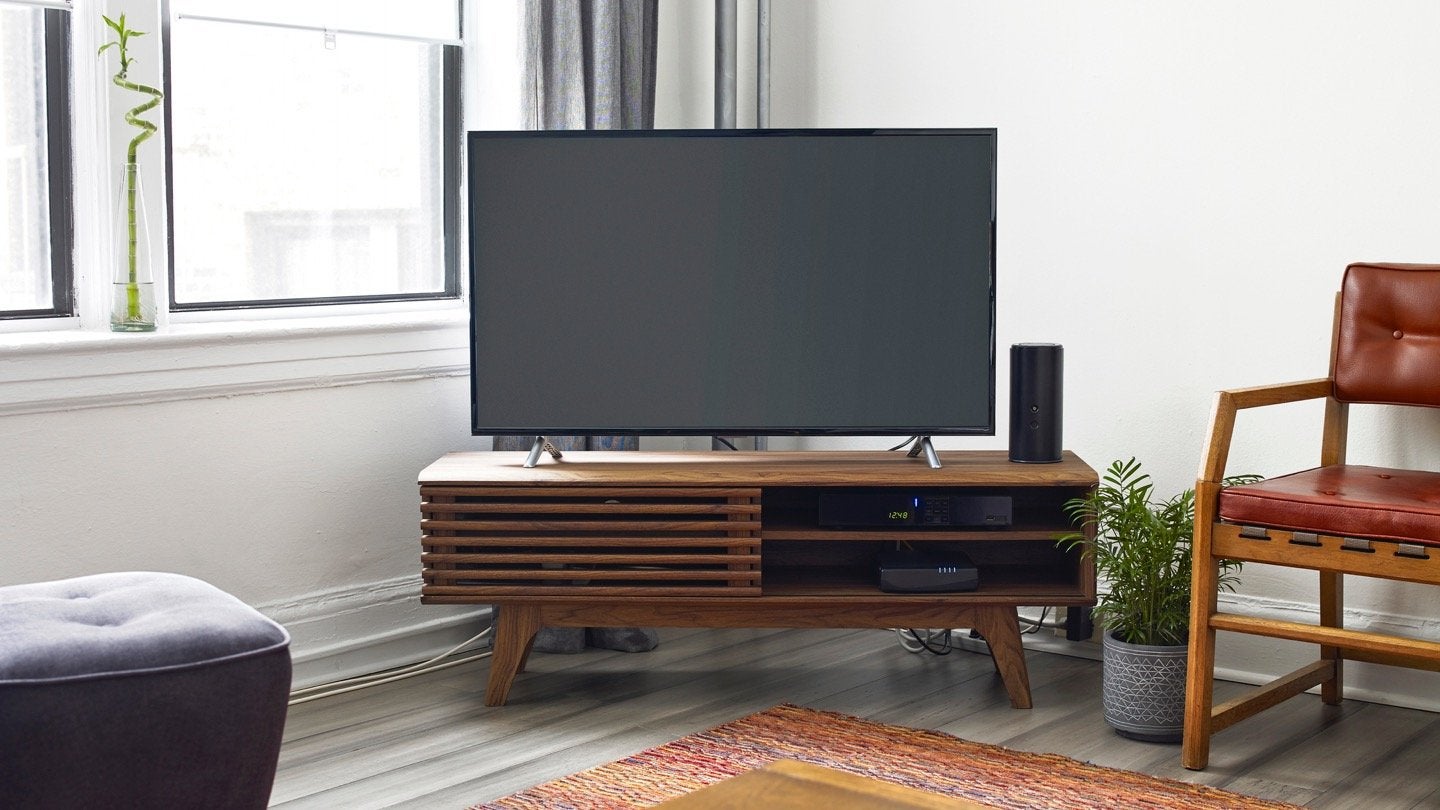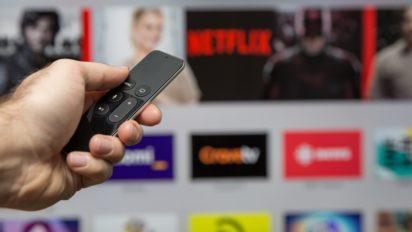Around 20 years ago, a new wave of TV innovation hit the market. It was HD, high-definition TV, and it was awesome. The enhanced resolution paved the way for bigger screens, DVD players and seemingly endless crystal-clear content.
Since HD became mainstream, there hasn’t been a major change in how we watch TV. Sure, 3D TV had people talking for a while, but as Digital Trends announced a few years ago, 3D TV is dead.
The newer TV trend, and one that has stuck around, is 4K. The first 4K TVs started hitting the market around 2012. However, TV and streaming providers only started ramping up the amount of 4K programming and content in the last few years. Here’s everything you need to know on how to get started with 4K TV.
Jump to section:
What is 4K TV?
4K TV is a serious upgrade in TV resolution. Also known as “Ultra-HD,” 4K TV features four times the number of pixels as HDTV. This results in a clearer, sharper image and deeper, bolder colors.
HD vs. 4K resolution
- HD: 1,920 x 1,080 pixel display
- 4K: 3,840 x 2,160 pixel display
How can I watch 4K TV?
Similar to the rollout of HDTVs and high-definition content, you’ll need a few things to achieve that higher state of resolution. Thankfully, as this new TV technology becomes more popular, 4K TVs are dropping in price, TV service providers are offering more 4K content and many new streaming devices support 4K. Here’s what you will need to enjoy 4K viewing in your home.
How to get 4K TV in your home
- Upgrade to a 4K TV
- Get a service that offers 4K content
- Upgrade your TV equipment
- Upgrade your internet
Upgrade to a 4K TV
4K TVs are now available everywhere you can buy electronics. Thanks to 4K’s increasing popularity and buy-in from major manufacturers like Sony, LG, Samsung and Vizio, prices for new 4K TVs are much more reasonable than in previous years.
An upgrade to a 4K TV might also include an upgrade in TV size. Our eyes aren’t capable of noticing the differences between HD and 4K on smaller TV screens, so including 4K resolution on a smaller TV is virtually pointless. Therefore, most TV manufacturers sell 4K TVs ranging from 43” to 80.” Keep that in mind if you’re shopping for a new TV.
Once you’ve got that new 4K TV, or if you already have one, you’ll find a few options for viewing 4K content.
Get a service that offers 4K content
Here’s a full list of providers that offer 4K TV content, including the types of content offered and the starting monthly price for service.
| Provider | Starting monthly price* | Service type | 4K content |
|---|---|---|---|
| Amazon Prime Video | $8.99 | Streaming | Select original series |
| DIRECTV | $64.99 | Satellite, internet | 3 full-time 4K channels, select On Demand titles |
| DISH | $69.99 | Satellite | Select On Demand titles, streaming platforms accessible via Hopper3 device |
| Netflix Premium | $19.99 | Streaming | Select original series |
| Xfinity | $19.99 | Cable | Select On Demand titles, streaming platforms accessible via X1 device |
| YouTubeTV 4k Plus | $84.99 | Live TV streaming | Varies |
*Pricing per month plus taxes for length of contract. Additional fees and terms may apply. Pricing varies by location and availability. All prices subject to change at any time. May or may not be available based on service address. Speeds may vary. As of 06/18/20.
TV providers and services that do not currently support 4K content include:
- Cox
- Spectrum
Upgrade your TV equipment, if necessary
Even if you have a 4K TV and a TV service that offers 4K content, you might still need equipment that supports 4K to view it.
TV providers DIRECTV, DISH and Xfinity have specific receivers for 4K content. If you already have one of these services, you may need to upgrade your receiver to one that supports 4K. Or, if you are shopping for a new TV service, ask about 4K receivers when you place your order.
If you want to stream 4K content you may be able to do so from built-in apps on your smart TV. Otherwise, you’ll need a compatible 4K streaming device.
Streaming devices compatible with 4K TV:
- 4K Roku
- Amazon Fire
- Apple TV 4K
- Google Chromecast Ultra
- Playstation 4 Pro
- Xbox1
Additionally, some Blu-Ray players support 4K and will play 4K Blu-Ray movies. 4K Blu-Ray movies are available at most electronic stores, and Redbox currently offers 4K Blu-Ray movies for rent. Not all Blu-Ray players support 4K, so make sure the one you have or want to purchase does if you want to use it to watch 4K movies.
Upgrade your internet, if necessary
Streaming 4K content requires a lot of bandwidth, considerably more than most other online activities. To stream 4K TV content without tons of buffering, you’ll need a fast internet connection, preferably one with high monthly data allowances or no data caps at all.
The FCC recommends internet speeds of 25 Mbps or higher for streaming 4K. Keep in mind that there are many factors that can affect internet speeds, so internet plans with advertised speeds higher than 25 are best for streaming 4K content.
FAQs on 4K content
Pixels are tiny dots that make up your TV screen image. The more pixels a TV screen has, the finer detail a TV screen can produce. The number of pixels determines a screen’s resolution. Here are the pixel ratios for common TV resolutions:
- Standard definition (SD) – 704 x 480
- High definition (HD) – 1,280 x 720
- Full HD – 1,920 x 1,080
- 4K (Ultra HD) – 3,840 x 2,160
HDR, or High-Dynamic Range, is a term you might hear along with 4K and Ultra-HD. While both involve picture and clarity, they are a bit different. 4K is essentially just more pixels, but HDR is an upgrade to what those pixels can do.
According to businessinsider.com, HDR boosts a display’s contrast ratio, allowing for finer detail between light and dark colors. For the optimal TV experience, choose a TV that supports 4K and HDR.
If you purchased your HDMI cables within the last decade, probably not. Forbes reported that High-Speed HDMI cables, which support 4K performance, were introduced in 2009, so don’t feel like you have to run out and purchase HDMI cables specifically for 4K. Those new “4K HDMI cables” are likely just a higher-priced version of what you already have.
New 4K TVs can range from a couple hundred to a couple thousand dollars. Prices for 4K TVs have dropped considerably in recent years, but they have now somewhat leveled off. Don’t hold out too long for a 4K TV with the expectation there will be dramatic price drops anytime soon.
Yes. As 4K continues to grow in popularity, more 4K TV broadcasts, 4K streaming services, movies and video games will undoubtedly become available. 4K is here to stay, and 4K TVs and content will likely soon be as commonplace as HD TVs and channels.
Written by:
David AndersSenior Writer, Broadband Content
David joined the Allconnect team in 2017, specializing in broadband and TV content. His work has been referenced by a variety of sources, including ArcGIS, DIRECTV and more. As a Senior Writer, David is motivate…
Read more
Edited by:
Trey PaulEditor, Broadband Content
-
Featured
![What you need to stream TV: A beginner’s guide]() What you need to stream TV: A beginner’s guide Joe Supan — 9 min read
What you need to stream TV: A beginner’s guide Joe Supan — 9 min read -
Featured
![Could 4K streaming video and gaming quickly eat up your data limits?]() Could 4K streaming video and gaming quickly eat up your data limits? Joe Supan — 4 min read
Could 4K streaming video and gaming quickly eat up your data limits? Joe Supan — 4 min read -
Featured
![Streaming vs. cable: Which TV service is better?]() Streaming vs. cable: Which TV service is better? Camryn Smith — 5 min read
Streaming vs. cable: Which TV service is better? Camryn Smith — 5 min read
Latest
-
Thursday, July 25, 2024
Worried about losing your signal? This is how to keep your satellite dish cleanDavid Anders — 6 min read
-
Tuesday, July 23, 2024
The best free TV and movie streaming services 2024Camryn Smith — 5 min read
-
Tuesday, July 23, 2024
Everything you need to know about internet speedsRobin Layton — 8 min read





